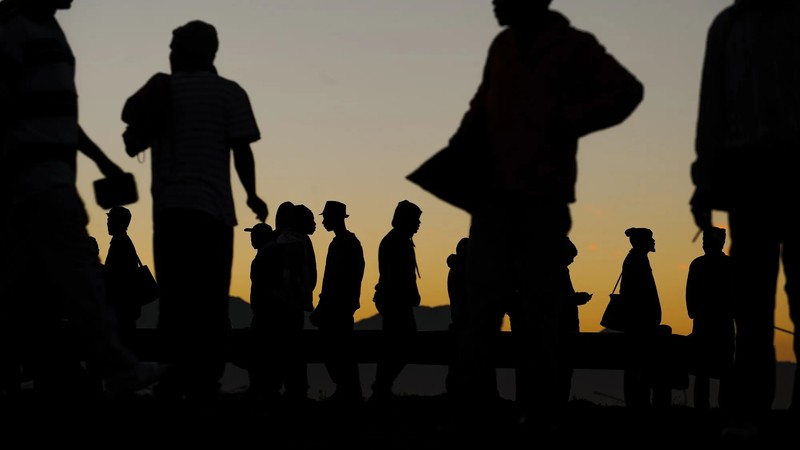South Africa’s food security is getting worse, despite the government spending billions to try to stop hunger levels rising. It is a losing battle, because the government strategy is flawed. Instead of policies that would reduce the number of poor people, it is throwing huge resources at efforts to make an increasing number of poor people less hungry.
The result is that food security surveys regularly show that the number of hungry people is rising, and every quarterly jobs report shows that, even when percentages improve slightly, the actual number of unemployed people is going up.
One of the world’s highest unemployment rates results in high levels of poverty, hunger and starving children. Even though South Africa is food secure at national level, producing enough to export, the situation at household level is getting worse, not better. Millions and millions of South Africans are going hungry because they cannot afford food that is available.
At a recent social justice summit, with themes of food security and peace, President Cyril Ramaphosa noted that 15 million to 16 million South Africans had inadequate or severely inadequate access to food. He then proudly listed government efforts to reduce hunger and improve food security. These included school feeding schemes and community nutritional programmes, as well as social grants, free basic services, free basic and tertiary education and free primary healthcare to free up money in households to buy food. He boasted that, in South Africa, the social wage accounts for approximately 60% of spending by government before interest payments.
These worthy activities are not a measure of success – they are proof of failure. The government is devoting most of its spending in a never-ending battle to alleviate poverty and hunger. Economists have told the government repeatedly that the only answer to poverty and unemployment is economic growth, which creates jobs. We need growth of 4% and 5% a year, yet World Bank statistics show that since 2022, annual GDP growth has been below 1%. The forecast for 2026 is 1.1%.
Population growth is outstripping economic growth. And the growing number of poor people are outstripping the government’s ability to sustain them with handouts. Handouts and feeding schemes meet a desperate need – the aim should be to reduce that need.
Government policy should focus firstly on economic growth and job creation. That should be the target of every government minister, every department and every official. The growth target should be 4%, for a start, with realistic policies that can get us there.This means policies that encourage investment, remove barriers to employment and make it easier for entrepreneurs to establish small scale businesses and create jobs. Economists seem concerned that, at the moment, policy is having the opposite effect.
Secondly, it should prioritise the production of plentiful and affordable food so that the rising number of people with jobs can provide their families with a nutritious diet. That is a job not only for the agriculture department – it involves road and rail transport, harbours, water services and all the other factors that affect the food production chain.Year after year, agricultural experts and organisations point to logistics failures that prevent the efficient transport of essential inputs to farmers and the efficient transport of farm produce to local and export markets. All of this has an effect on food production and food prices – and, ultimately, on household and national food security.
Electricity shortages seem to have been solved, at least for now. But, with regular warnings that load shedding could return, food producers must purchase and maintain expensive power generation and battery storage systems. Water is an essential agricultural commodity, from food production to crop irrigation. Yet local municipalities are struggling and some are unable to provide regular or reliable water supplies.
South Africa’s largest poultry producer, Astral, is spending R100 million on a pipeline to bring water from the Vaal River to a production plant in Mpumalanga. All of these failures make farming more difficult and the costs have implications for food prices and food security.South Africa will never feed its hungry millions with government subsidies and handouts. The solution lies in the private sector, which the government must support through policies that that make growth and investment easier, job creation easier and farming and food production easier.
Keeping farming costs down, including electricity and transport costs, will help keep food prices down.The government should pay special attention to costs affecting the industries that pay the biggest part in feeding the nation. These include grain and poultry. Grain is essential not only for food production, but also for livestock feed. The poultry industry consumes nearly half of the annual maize crop.
Chicken is an enormous component of the South African diet, and it is vital for low-income households. Chicken comprises 66% of the meat eaten annually – the chicken industry produces nearly twice as much meat as the beef industry, and four times the meat produced by pig farmers. A quick win in reducing food prices, especially for the poor, would be to remove value added tax (VAT) from the chicken portions most consumed by low-income households. VAT-free chicken would enable an immediate 15% reduction in the chicken portions essential for feeding poor families and for addressing child malnutrition.

Francois Baird is founder of the FairPlay movement
*** The views expressed here do not necessarily represent those of Independent Media or .
BUSINESS REPORT
